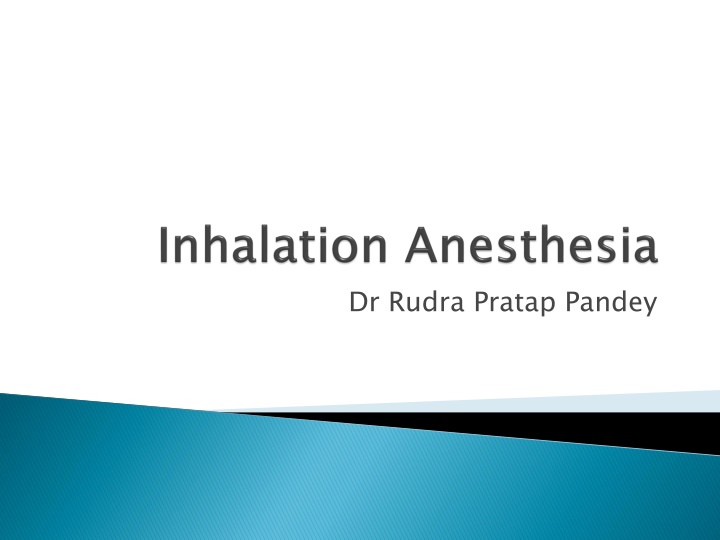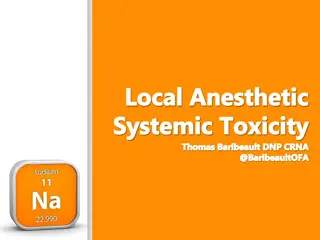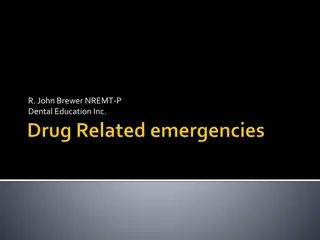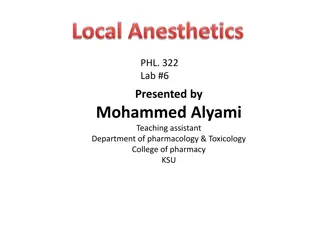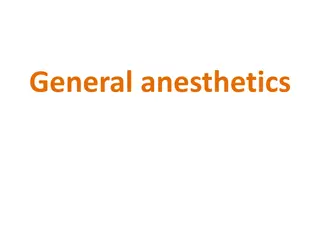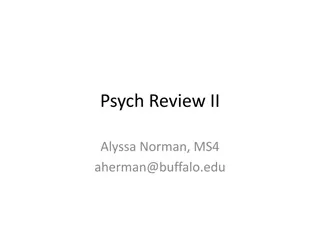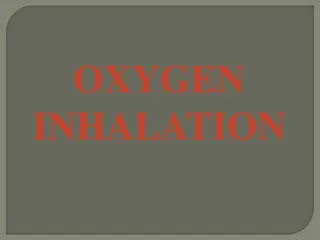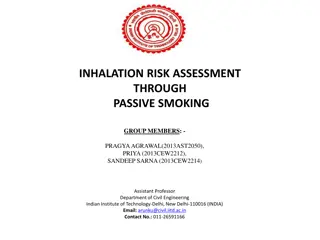Inhalation Anesthetics: Delivery and Administration
Inhalation anesthetics offer rapid adjustment of anesthetic depth via the lungs but require specialized apparatus for delivery. This includes oxygen source, breathing circuit, and a vaporizer. Additionally, oxygen cylinders, MAC measurement, and blood gas partition coefficient play crucial roles in administering inhalation anesthesia.
Uploaded on Feb 15, 2025 | 0 Views
Download Presentation

Please find below an Image/Link to download the presentation.
The content on the website is provided AS IS for your information and personal use only. It may not be sold, licensed, or shared on other websites without obtaining consent from the author.If you encounter any issues during the download, it is possible that the publisher has removed the file from their server.
You are allowed to download the files provided on this website for personal or commercial use, subject to the condition that they are used lawfully. All files are the property of their respective owners.
The content on the website is provided AS IS for your information and personal use only. It may not be sold, licensed, or shared on other websites without obtaining consent from the author.
E N D
Presentation Transcript
Inhalation anesthetics are administered, and in large part removed from the body, via the lungs. Their pharmacokinetic characteristics favour predictable and rapid adjustment of anesthetic depth (advantage) but for delivery, a special apparatus is required (disadvantage). This apparatus includes a source of oxygen (O2) and a patient breathing circuit that in turn usually includes an endotracheal tube or face mask, a means of eliminating carbon dioxide (CO2), and a gas reservoir or vaporizer.
A vaporizer is a device to permit controlled exit of aesthetic vapours (concentration calibrated or measured flow mechanism) in measured concentration. Basically of 4 types FO or flow over type Wick type Inject type Bubble through type
Oxygen cylinder: 7000L (H type) has approx. 2200 psi pressure which is reduced to 35 -50 psi after passing through regulators, meter and conduits. Oxygen cylinder has a white neck and is connected to anesthesia machine. Usually oxygen flow rate of 0.5-2.0 L/min is adequate for various species.
CBF and intracranial pressure increases in inhalation anesthesia. MAC is standard index of measuring potency of inhalation anaesthetics. MAC is defined as the minimum alveolar concentration of an anaesthetic at 1 atmosphere that produces immobility in 50% of subjects exposed to a supramaximal noxious stimulus (50% of the subjects get anaesthetized whereas, remaining 50% do not get to the desired level MAC is not affected by duration of anaesthesia, anticholinergic premedicants, >50mm Hg arterial pressure, gender, hyper or hypokalemia. MAC increases in hyperthermia or CNS stimulation and decreases due to drugs causing CNS depression. 50% of the subjects get anaesthetized whereas, remaining 50% do not get to the desired level).
Blood gas partition coefficient also called Ostwald coefficient in one solvent to the concentration in other solvent in state of equilibrium. BG partition coefficient of 1.7 means at equilibrium the concentration of gas in blood is 1.7 times more than in alveoli. The relationship is: Higher partition coefficient higher lipophilicity higher potency higher solubility more anaesthetic needs to be dissolved slower onset. MAC decreases as partition coefficient increases generally. Ostwald coefficient is the ratio of concentration of one compound
Breathing circuits should have minimum dead space, low resistance with a reservoir bag (capacity = body weight x 60 ml rounded off) Mapleson breathing systems Magil system
Tube size in dogs ranges from 1.5 to 15 mm Brachycephalics need less diameter ET)
General anesthesia can be induced by administering anesthetic gas mix via a facemask or other suitable delivery system connected to ET tube. Lignocaine spray can be used in dogs but not needed in cats for intubation. Forcing the ET tube may damage the mucosa and lead to post anaesthetic edema and obstruction. Laryngeal spasm is common in cats during extubation so tube should be removed when its in proper GA.
There are two methods; incremental or crash induction. Incremental induction technique uses 3 min of preoxygenation and then introduction of 0.5 % vapor setting for 30-60 seconds and then 0.5 % increment for the same period. Crash induction is achieved with 3-5 % vapor set of isoflurane following pre-oxygenation. It is preferable to use non-rebreathing circuits for quicker induction and then switched to the circle rebreathing systems even for animals weighing more than 6 kg.
General anesthesia can be induced by administering via a facemask or other suitable delivery system connected to ET tube. halothane (having Cl, Br and F), isoflurane (having Cl and F), sevoflurane (having only F), or desflurane
1 MAC halothane in dog is 0.8 %. Vapor setting is at 3-4 % at induction with oxygen flow at 60 ml/kg/min Vapor setting between 1-3 % during the maintenance with oxygen flow at 20 ml/kg/min. Halothane is largely being replaced by isoflurane everywhere due to its adverse effect on liver. As anesthesia is deepened by increasing halothane concentration, CO and arterial pressure decrease further. HR usually remains constant. Halothane can be used in isoflurane vaporizer and vice versa in emergency as the vapour pressure is almost equal for both.
1 MAC in dogs is 1.3% Isoflurane has replaced halothane both in human and veterinary markets worldwide Quicker anesthetic stabilization and more rapid recovery than halothane due to its lower blood gas solubility. Vapor setting is at 3-4 % in dogs at induction with oxygen flow at 60 ml/kg/min and is reduced between 1.5-3 % during the maintenance with oxygen flow at 20 ml/kg/min Isoflurane, similar to halothane, induces a dose-dependent cardiovascular depression. Isoflurane causes more peripheral vasodilation than halothane, which is responsible for a low arterial blood pressure, but tissue looks more bright and pink indicating better perfusion. Isoflurane is less prone to cause arrhythmia compared to halothane
Sevoflurane (1 MAC = 2.3 %) is less potent than halothane or isoflurane. Anesthetic induction, recovery, and intraoperative modulation of anesthetic depths are faster than halothane and isoflurane. More expensive than halothane and isoflurane. Sevoflurane induces dose-dependent cardiovascular depression to a degree similar to that of isoflurane.
